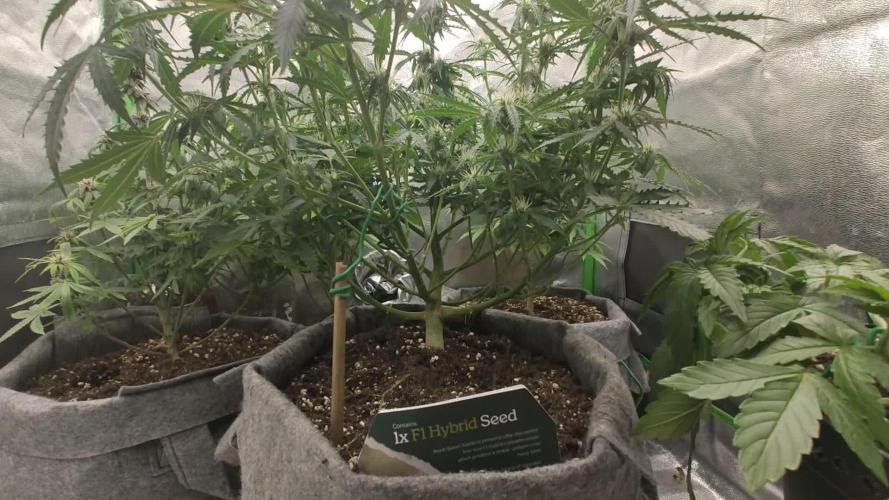The Grow Awards 2026 🏆 



































Likes
Comments
Share


@The_Bearded_Grower
Follow
Its that tome of the grow its time to flush and this time i'm trying a new product, its called flawless finish and i can wait to see what the results are. also so everyone knows i am using tap water and it has a ppm of around 500.
As you can see the buds are nice and fat and the trichomes are right ware i want them.
The flowers are starting to change color and i hope they will continue to change.
On a side note the all red light that i have been using for the last 2 weeks seams to be working out and the flowers look the be getting more trichome coverage.
That all for now if you have any questions feel free to ask and if you like this grow drop a like maybe even a follow, untill next time keep your stick on the ice
Likes
12
Share


@Northern_Ent
Follow
Aug 2: Tropicana Cookies FF is three weeks younger than my two biggest plants (Sunday Punch EV and Mimosa Shot) and two weeks younger than Lemon Cream Kush. This is a very strong plant and is progressing very well.
This wagon with LCK started force flowering a week later than the other wagon and will go another week longer.
TC is now the tallest of the four plants despite being the youngest.
Aug 5: now done force flowering after 2.5 weeks. Plants in this wagon are getting too big to easily get into garage. Continuing to use far red light as a bloom booster at dusk. Back to 15.5 h of daylight in the backyard now.
Aug 7: now 51 inches so she’s had a quick vertical growth spurt. Looking very happy with leaves ‘praying’ upwards nicely.
Processing
Likes
3
Share


@Dico29
Follow
Day 120
Smells good buds are fatter and looking better then I thought last week, I flushed but I think I may have caused nutrient burn or nitrogen since my stems have turned purple also along the buds and tips or ideas of what I should try thanks
Day 127 photos at the bottom
Likes
3
Share


@jaydee702
Follow
these two clones arent showing any sighns of hermi so far there mother was a hermi and its mother was 100 percent female .Still dont know how the hermis got stressed to turn from fem to hermi .this grow is female so far
Likes
16
Share


@Samsemilla
Follow
Die fünfte Woche startet mit einer (Teil-)Entlaubung, das Blätterdach ist wieder sehr dicht gewachsen.
Die Blätter bekommen wieder ein satteres grün.
Irgendwann innerhalb der nächsten Wochen sollten sie ihr Geschlecht zu erkennen geben, noch sind sie etwas schüchtern.
Ich sehe die ersten Anzeichen, kann es aber noch nicht klar deuten - abwarten und Tee trinken.
Ich habe dem Wassertank meines Autopot Systems einen Luftstein hinzugefügt.
Wird das einen großen Effekt bringen? - keine Ahnung.
Kann es schaden? - ich denke nicht.
So langsam zeigen sich die ersten weiblichen Vorblüten, ich kann aber noch nicht bei allen 13 Pflanzen mit Sicherheit das Geschlecht bestimmen.
Likes
45
Share


@Mosquito_Haarlem
Follow
Heerlijke harde volle toppen en voor het eerst dat ik harsdruppels zie.
Een heerlijke strain om te growen.
De plant wordt in zijn geheel opgehangen en ik zal het droge gewicht wegen.
Likes
17
Share


@JonnyKush
Follow
hey guys sorry for the absence but in this period I have had a lot to do with my work and I have not been able to bring a good detailed diary, but finally now the holidays will start and I will be able to dedicate myself 110% to a new crop and new ones diaries. having said that, I think I will leave him a week at the most and finally reap the benefits 💚🌳💚🌳maybe my fault the RQS slow release nutrients did not perform as much as the ADVs in my tent, you can see it from the video of 27/07/22 where you can see that 2 out of 6 plants are visually leaner and less compact to the touch , I wanted to try on the same varieties in order to have feedback. I think it could also be caused by the crowding of the tent but with the ADV I have not encountered any problems. I will definitely try them again, giving them much more attention.
Likes
21
Share


@DeepWaterGrower
Follow
🗓️ WEEK 8 (flo) - HARVEST WEEK (56° FLO)
💧 Midway through this final week of flowering, I performed a complete DWC reservoir change. I replaced the nutrient solution with plain tap water, EC 0.4 - pH 5.8. This flushing solution was maintained for 4 days, right up until the moment of harvest.
🌱 On the 56° day of flowering (day 84 from the dry seed), the plant appeared perfectly ready for harvest. The buds are dense and glistening with resin, nearly all pistils have browned and retracted, and the trichomes show a beautiful mix of milky and enough amber. Immediately after chopping her down, I removed all the large fan leaves and I've decided to dry these too as they are remarkably full of resin.
✅ DRYING PHASE
The entire plant was hung to dry inside the grow box, which was kept completely dark with constant, gentle air circulation for 8 days.
The average VPD during this period was maintained around 1.2 (approximately 20°C and 50% RH). Once this drying period was complete, I trimmed off all the sugar leaves. These resinous sugar leaves will be combined with the already dried fan leaves and larf buds, and I plan to use them to make cannabutter for edibles.
⚖️ DRY WEIGHT
After the 8-day drying period, and once all the remaining small leaves and branches were removed from the buds, I weighed the final product:
The harvest yielded:
- 150 grams of dense buds.
- 5 grams of finger hash collected during handling.
For edibles:
- 30 grams of larf.
- A large amount of fan and sugar leaves.
⚠️ In the next coming days I'll update the harvest week with info about curing stage and a smoke review.
Likes
77
Share


@biggreens420
Follow
This girl is doing well bushing up nicely after fimming gone a bit pale so hit her with the Shogun nutes now she's settled put a video up of feed one of ec and one of pH when using Shogun i don't do it that often as it's always roughly the same just when n flower I'll switch the calmag and silicon for a pk and a boost max it goes is 2.2 ec her side branches are coming on well hoping the feed sort her colour out other than hat she seems happy not slow drinking well nice chunky stems will get some better pics when possible thanks for reading happy growing guys
Likes
65
Share


@Dendegrow
Follow
So the net is installed, lets wait until it is full covered and then going into bloom. I make this time a trial only to feed the Organe sherbet with Melass yeast buddermilk and sugar in vegetation. The yeast will produce the whole grow enough co2 to keep it up about 800 ppm only thing you have to do is to put some sugar in the feeding solution.
Likes
4
Share


@pzwags420
Follow
gsc is about a week away from harvest blueberry will be shortly after and og kush plus blueberry muffin are a little longer still, they were slow to start flowering.
Likes
23
Share


@Dmon88
Follow
I was very surprised with the outcome i didnt expect much from an auto much less a first grow but my has she really impressed id suggest for a first time growing but im going to start searching for higher potency strain with better germ rates this was the only 1 of 5 who pulled threw. im working on my next run and will be catching it up later today0
Likes
7
Share


@HegauHillsFarmers_M11
Follow
Tag 56 - Beginn der 9 Woche.
Die Blüten entwickeln sich weiterhin gut, sie sind schön frostig und duften stark und süßlich. Leider wurden die Blätter immer gelber und fallen teilweise ab. Für mich ist das anhand der Symptome diese Woche eindeutig geworden, dass die Pflanze hier mit zu viel Licht und Hitze zu kämpfen hat. Leider kann ich die Lampe nicht weiter hoch stellen ohne das es die andere Pflanze beeinflussen würde. Deshalb habe ich das Düngeschema nicht geändert und weiterhin Cal-Mag dazu gegeben damit sich die Pflanze vor der Lichtintensität und der Hitze besser schützen kann.
Gedüngt wurde an Tag 51 der letzten Woche.
Nährstofflösung:
1 ml/l - Sensi Cal-Mag Xtra Advanced Nutrients.
1 ml/l - Big Bud Advanced Nutrients
1 ml/l - Bud Candy Advanced Nutrients.
1 ml/l - B-52 Advanced Nutrients.
2 ml/l - pH Perfect Sensi Bloom Part A.
2 ml/l - pH Perfect Sensi Bloom Part B.
Likes
Comments
Share


@Backyardnewbie
Follow
Plant is small or stunted hopefully it picks up. Plant is going through a stretch.
Likes
11
Share


@BudBeezy
Follow
Welcome to week 23 of my grow diary. Unfortunately, this is also the last week. During my daily check for mould, I noticed that one of the headbuds looked suspicious. The spot was right in the tip of one of the headbuds. In the video you can see that I have generously removed the tip. This was also the reason for the harvest. I actually wanted to leave the plant for a few more days but the mould made me decide to harvest it earlier. During the harvest, I discovered mould in the early stages in 2 other places. The flowers were trimmed wet and checked thoroughly.
I hope you enjoyed my grow diary. If you have any questions, please feel free to ask me.
All in all, I really liked this strain. Apart from the last case of mould, I had no problems with the plant. It survived the mainlining well. During this experiment I was able to gain a lot of experience for future grows. If I could travel back in time again, I would decide to leave fewer side shoots in the vegetative phase as it is already quite overgrown.
Thank you for following me so far. I will give you an update after it has dried.
See you next week ✌️
Likes
1
Share


@Albagrows13one
Follow
Flowers coming in slowly but surely there's a large difference in size between the lst plant and the others.
Likes
7
Share


@KannaKullektiv
Follow
Hiiigh friends 🙌
Welcome to week 8. 😍
Due to too much unwanted stress, flowering is delayed. The big lady was unable to withstand the training. Her neck is broken. But she is far from giving up and will fight to the end.. 😊
See you next week. 👋
Arturo for KannaKullektiv
🙏
Likes
7
Share


@BeautyBudsVio
Follow
Enough is enough right?
Cuz my stash is empty we had to cut him now
Trichomes are milky no clear
Smell is very strong
5 hours Trim Job
Way toooooo much Leafs this time
Think it’s time to buy an Automtic Trimmer


















